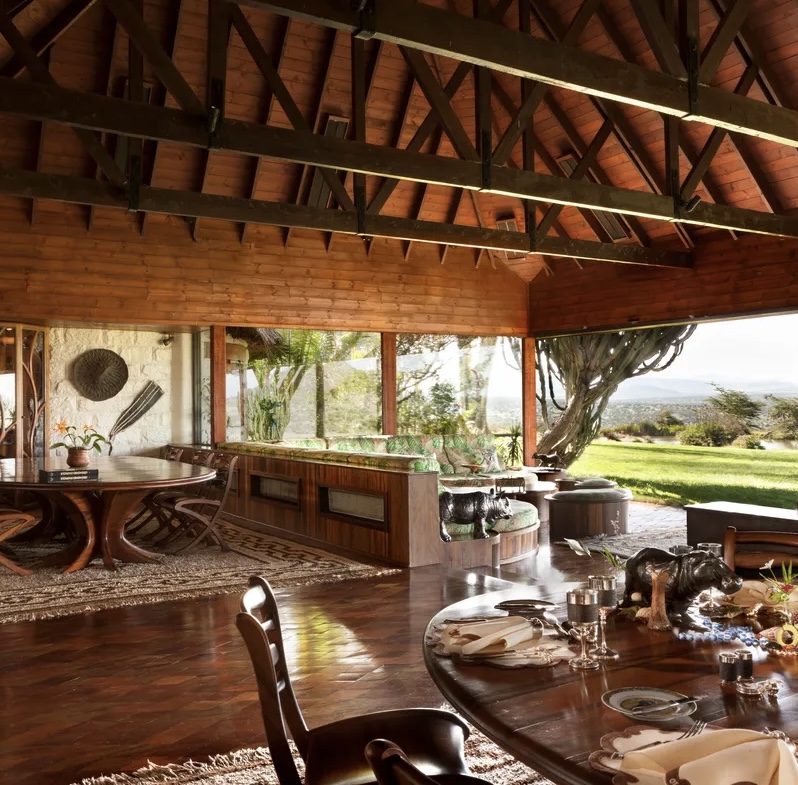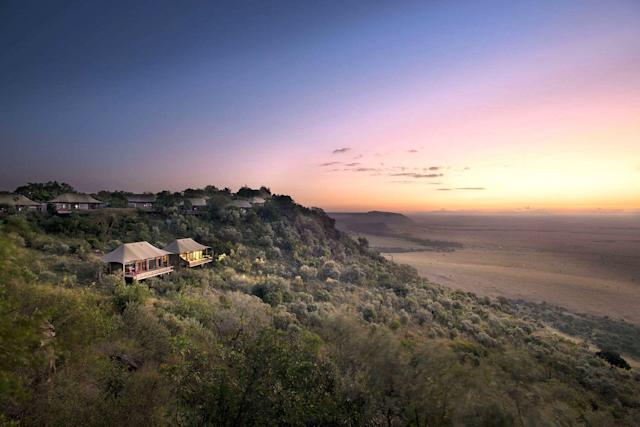Business
Top 12 Resorts in Kenya: Readers’ Choice Awards 2021

What’s the vibe? Angama Mara, which opened in 2016 and sits on top of the Oloololo escarpment overlooking the Mara Triangle, comprises two camps. Each one contains 15 suites with canvas sides and tented roofs, but they also have glass fronts, giving you gobsmacking, 180-views of the savannah, whether you’re lying in bed or taking a shower. This is no traditional safari set-up: the sleek, Italian-inflected design gives the place a bit of cosmopolitan flair, as does a pavilion with a library, shop, fitness room, and infinity pool—all while embracing the wild surroundings.
How about the safaris? Breaking from the two-a-day game drive model, Angama structures your wildlife doses around whatever you’re feeling up for—full day, two hours, bird-focused, driving, walking…whatever you’re feeling. The action—where you’ll see plenty of the Mara Triangle’s Big 5—is ten minutes down the private road. From your suite, you’ll also be able to watch elephant, buffalo, and giraffe milling about, not to mention the raptors dipping above your head. If you’re physically antsy, there are plenty of opportunities for Maasai-led walking safaris, too.
And the food situation? The restaurant, a mashup of modern and traditional Maasai aesthetics, does a kind of international à la carte menu that you can eat in the restaurant or on your suite’s deck, or have as a picnic on a nearby kopje where scenes from Out of Africa were filmed.
Got it. What can we expect from the bedrooms? The tented suites are much bigger, lighter and more extravagantly kitted out than before, and have dreamy glasshouse bathrooms with a Victorian tub and courtyard shower. Private decks with sunken lounges take in the quintessential Mara view. Vintage silver, crystal decanters, leather armchairs, and extravagantly deep sofas were reused, recycled or reupholstered, while historic, old-world maps and brass fittings were added.
Perfect. How about the food and drink? The chef is a local Kenyan named Michael Jackson. He listens, and remembers what you express an interest in—on a picnic lunch out in the reserve, the guide produced ice cream for dessert, because he knew we’d loved it at the lodge. There’s plenty of fresh fish, salads, lamb, soups and homemade bread.
That’s lovely. On that note, anything else to say about the service? It’s warm, genuine, kind and thoughtful; you even get your own private butler. If you enjoy the feeling of being taken care of, you will love it.
Oh, we do. What type of person stays here? A mix of first-timers to Africa and experienced safari-goers. There are families, couples, and small groups on a safari circuit around East Africa. Guests are affluent and sophisticated travelers of all nationalities. The soundtrack is running water, birds, monkeys and, at night, the roar of lions in the distance, or the cry of a hyena pack.
Who wouldn’t want to hear that? Can you tell us a little more about the setting, the environs? You’re hidden in a magical, forested setting. The access to the next-door camp makes the property feel that much bigger—and they have a vegetable garden, where you can walk around and talk to the gardeners. You can also walk between your tented suite and the gin bar, gym, boutique, and spa. Each of the two small camps has its own pool overlooking the Mara plains, where you can eat lunch.
A gin bar! We’ll happily try that. So, is it worth it—why? On any given day, the open plains are alive with memorable sightings: a 40-strong herd of elephant, a week-old giraffe galloping clumsily after its mother, hundreds of zebra and antelope, a pair of black-backed jackals trotting through the long grass, or lions snoozing on a little-used track.
How about the safari? Some of the largely Maasai staff and guides have been with Cottar’s for decades, and have become leaders in their industry and role models to their tribal members. Three are Gold Level KPPA guides, the highest level Kenya offers. Calvin Cottar is a spectacular guide himself, and has won the award for Best Guide in Africa three times. (If you’re lucky, he may even take you out to explore; you may also book him on a private basis.) The huge private concession borders the Masaai Mara, which is one of Africa’s great wildlife refuges and seasonal home to the Great Migration, when 1.5 million wildebeest and zebra cross its massive plains. All the iconic species of Africa live in great numbers in the Mara, and as a result, frequent the private concession of Cottar’s Camp as well.
Any other outings? Given its longstanding relationships in the region, Cottar’s also does some unique cultural excursions, like Maasai wedding blessings and visiting the Maasai Warrior School.
Now tell me about the tents. Each tent is furnished with pieces and fabrics collected by Liz (who also co-owns the stylishly eclectic One-Forty-Eight boutique hotel in Nairobi) on her travels—think slipcovered chairs, and textiles and rugs from all over Africa—for a Boho-chic castaway feeling.
And how about the safaris? Choose from day and night game drives looking for the Mara’s Big Five; birding; bush walks; visits to a local Maasai Village; and hot air ballooning (for an additional cost).
How’s the food? Even though the camp is small, the chefs here have a ton of experience in kitchens around Kenya, and will do traditional African food, if you want, or Western dishes if you prefer. You can eat outdoors at a candlelit table, or even do a bush dinner over an eco-friendly charcoal oven.
Is there a do-good component? Where’s my money going? In 2011, Richard and Liz founded the Mara Elephant Project, which addresses human-wildlife conflict mitigation and anti-poaching through the collaring, monitoring, and tracking of elephants.
Of course, it actually is wild—there are no fences between you and the wildlife at the nearby watering hole. Grevy zebras, reticulated giraffes, families of warthogs, and elephants might stroll by during the day, while hippos are known to graze on the lawn at night. Elsewhere on the conservancy, you’ll be able to see rhinos, lions, buffalo and oryx.
What’s the backstory?
Beyond the main house—which was originally designed as a private home—Ol Jogi is a 58,000-acre private wildlife conservancy, with projects ranging from animal rescue and rehabilitation to anti-poaching protection (there’s a K-9 unit of bloodhounds to track poachers). Ol Jogi also has community outreach programs, including a primary school.
Tell us all about the accommodations. Any tips on what to book?
There are 13 suites at Ol Jogi, named for different animals you might see around. The two master suites, Simba and Mgobo (lion and buffalo in Swahili), are the most ornate. Connected by a central lobby, the two accommodations feature a maze-like arrangement of circular rooms, from dressing rooms to bedrooms to bathrooms, each bedecked in bold patterns and extravagant materials. The rest of the cottages, however, are a little more reserved in their decor, with safari-style color palettes and rattan furniture.
Is there a charge for Wi-Fi?
No, but it can be a little slow, especially in some of the farther-out suites.
Drinking and dining—what are we looking at?
As Ol Jogi is an exclusive-use property, you’re in control of the menu here. The kitchen staff can whip up pretty much anything your heart desires, whether you’re looking for a formal five-course dinner or a light afternoon snack. The baked goods served with tea are particularly delicious and shouldn’t be missed.
And the service?
Under the watchful eye of house manager Fred, who is the epitome of a gentleman, the Ol Jogi staff runs a tight ship, which is impressive given the size of the site. The service is absolutely impeccable. (Pro tip: ask the Fred to show you the owner’s collection of dinnerware, silverware, and glassware. You haven’t lived until you’ve held a vintage Dior cheetah teacup.)
We’d also like to give a shout out to wildlife manager and conservationist extraordinaire Jamie, whose passion for the animals he works with is unparalleled in Kenya.
What type of travelers will you find here?
Ol Jogi can be booked out by a single couple, a multigenerational family, or even a corporate group—there’s plenty of room for everyone.
Any other hotel features worth noting?
There’s a James Bond–like wine cellar hidden away somewhere on property—we won’t tell you where so as not to spoil the surprise.
Bottom line: Worth it? Why?
There’s nowhere in the world quite like Ol Jogi. Between the maximalist decor, and the abundant wildlife, and the privacy (and philanthropy) of the conservancy, it’s a must-stay when in Kenya.
Originally Appeared on Condé Nast Traveler
Kenya Insights allows guest blogging, if you want to be published on Kenya’s most authoritative and accurate blog, have an expose, news TIPS, story angles, human interest stories, drop us an email on [email protected] or via Telegram
-

 News5 days ago
News5 days agoTemporary Reprieve As Mohamed Jaffer Wins Mombasa Land Compensation Despite Losing LPG Monopoly and Bitter Fallout With Johos
-

 Sports4 days ago
Sports4 days ago1Win Games 2025: Ultimate Overview of Popular Casino, Sports & Live Games
-

 Business2 weeks ago
Business2 weeks agoPanic As Payless Africa Freezes With Billions of Customers Cash After Costly Jambopay Blunder
-

 Investigations5 days ago
Investigations5 days agoFrom Daily Bribes to Billions Frozen: The Jambopay Empire Crumbles as CEO Danson Muchemi’s Scandal-Plagued Past Catches Up
-

 Business2 days ago
Business2 days agoEABL Under Probe Over Controversial Sh16.8 Billion Bond Raised Before Disclosing Change in Control
-

 Business5 days ago
Business5 days agoHass Petroleum Empire Faces Collapse as Court Greenlights KSh 1.2 Billion Property Auction
-

 Investigations2 weeks ago
Investigations2 weeks agoHow SportPesa Outfoxed Paul Ndung’u Of His Stakes With A Wrong Address Letter
-

 News5 days ago
News5 days agoShanta Gold’s Sh680 Billion Gold Discovery in Kakamega Becomes A Nightmare For Community With Deaths, Investors Scare





























